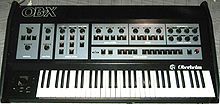Oberheim OB-X
| OB-X | |
|---|---|

Oberheim OB-X
|
|
| Manufacturer | Oberheim |
| Dates | 1979 - 1981 |
| Price | US$4,595 - US$5,995 |
| Technical specifications | |
| Polyphony | 4, 6 or 8 voices |
| Timbrality | Monotimbral |
| Oscillator | 2 VCOs per voice |
| LFO | 1 |
| Synthesis type | Analog Subtractive |
| Filter | 12dB per octave resonant low-pass |
| Attenuator | 2 x ADSR; one for VCF, one for VCA |
| Aftertouch expression | No |
| Velocity expression | No |
| Storage memory | 32 patches |
| Effects | None |
| Input/output | |
| Keyboard | 61-key |
| External control | CV/Gate |
The Oberheim OB-X is an analog polyphonic sound synthesizer.
First commercially available in June 1979, it was introduced to compete with the Sequential Circuits Prophet-5, which had been successfully introduced the year before. About 800 units were produced with moderate success before the OB-X was discontinued in 1981, replaced by the updated and streamlined OB-Xa. The OB line developed and evolved after that with the OB-8 before being replaced by the Matrix series.
The OB-X would be used in popular music by Rush (on Moving Pictures and Signals), Nena, Styx member Dennis DeYoung (used frequently from late 1979 to 1984), Queen (their first synthesizer on an album), Prince, a keen user, and Jean Michel Jarre who used it for its massive "brass" sounds.
The OB-X was the first Oberheim synthesizer based on a single printed circuit board called a "voice card" (still using mostly discrete components) rather than the earlier SEM (Synthesizer Expander Module) used in Oberheim semi-modular systems, which had required multiple modules to achieve polyphony. The OB-X's memory held 32 user-programmable presets. The synthesizer's built-in Z-80 microprocessor also automated the tuning process. This made the OB-X less laborious to program, more functional for live performance, and more portable than its ancestors.
...
Wikipedia
